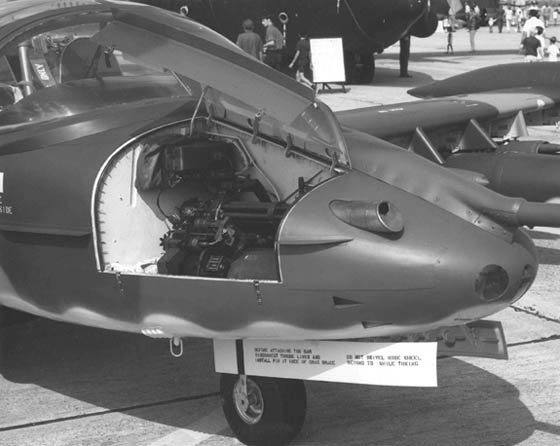WARBIRDS RESOURCE GROUP > VIETNAM > DRAGONFLY > PREVIOUS PAGE
Design and Development
The Air Force found the T-37 promising, but wanted an improved version of the aircraft that could carry a much larger warload, and had much greater endurance, as well as better short-field performance. This meant a heavier aircraft with more powerful engines. In 1963, the Air Force awarded a contract to Cessna for two prototype YAT-37D aircraft: T-37s with modifications that included:
– Stronger wings.
– Three stores pylons on each wing.
– Larger wingtip fuel tanks of 360 litre (95 US gallons) capacity.
– A General Electric GAU-2B/A 7.62 mm "Minigun" Gatling-style machine gun, with a
rate of fire of 3,000 rounds/minute and 1,500 rounds of ammunition. The weapon was
fitted in the right side of the aircraft's nose behind a large, convenient access panel. A
gunsight and gun camera were also fitted.

– Tougher landing gear for rough-field operation.
These changes meant a drastic increase in aircraft weight, and the aircraft now had to carry a serious warload as well, so Cessna replaced the two Continental J-69 engines with General Electric J85-J2/5 turbojet engines with 10.7 kN (2,400 lbf) thrust each, twice as powerful as the old Continental J-69s.
The first YAT-37D flew in October 1964, followed a year later by the second prototype. The second prototype had four stores pylons under each wing, rather than three, and the first prototype was upgraded to this configuration as well.
Test results were good, but USAF interest in COIN aircraft had faded for the moment. The program went into limbo for a time, with the second prototype "put out to pasture" at the Air Force Museum at Wright-Patterson Air Force Base in Ohio.
However, the war in Southeast Asia continued to escalate. Losses of Douglas A-1 Skyraider close-support aircraft in US and South Vietnamese hands proved greater than anticipated, and so USAF interest in COIN aircraft revived. The YAT-37D seemed like a promising candidate for the job, but the Air Force felt the only way to be sure was to evaluate the aircraft in combat.
As a result, the USAF issued a contract to Cessna for a preproduction batch of 39 YAT-37Ds, with a few minor changes relative to the prototypes, to be rebuilt from existing T-37Bs. These aircraft were initially designated AT-37D, but the designation was quickly changed to A-37A. The second prototype YAT-37D was pulled out of the Air Force Museum and upgraded to A-37A standards as part of the test program.
The A-37A had a gross takeoff weight of 5,440 kg (12,000 lb), of which 1230 kg (2,700 lb) was warload. The A-37A retained the dual controls of its T-37B ancestor, allowing it to be used as an operational trainer.
In combat "forward air control (FAC)" operations, the second seat was occupied by an observer. Only one crewmember normally flew in the aircraft for close support missions, permitting a slight increase in warload.
Sources:
Wikipedia: A-37 Dragonfly
WARBIRDS RESOURCE GROUP > VIETNAM > DRAGONFLY > PREVIOUS PAGE
